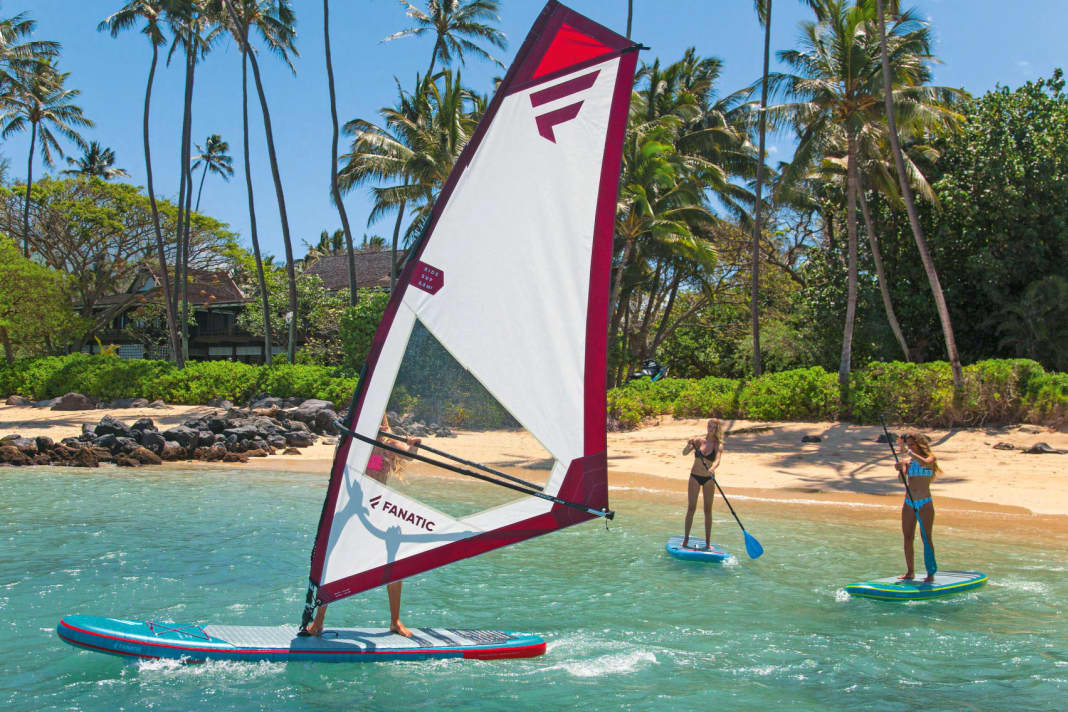





The topics in this buying guide:
When the wind is only lightly fanning the water, there's not much going on at first. But at some point, the first people with windSUPs and longboards take to the water at many all-round spots. They cruise, practise a few jibes and sailing tricks - or play old-school rhythms while riding on the edge. People are having fun - in wind force two.
Your own WindSUP or longboard (Test SUP 1/2022) are probably only owned by very few windsurfers. Although such models are rarely or never advertised by the brands, many manufacturers still have a suitable board in their range. So it's time to introduce you to the best dual-purpose boards so that you can spend more time on the water again - even in force two winds.
What makes a SUP a WindSUP?
Since stand-up paddling has become a popular sport, SUPs are available in every DIY store or even at discount stores. However, for such a board to be suitable for windsurfing, it must have certain features:
Mast base support:
Inflatable WindSUPs have a thread for the base plate glued into the deck. A conventional mast base can be screwed in here to connect the board and sail. Some fixed wind SUPs also have a fully-fledged mast track built into the deck. The advantage: You can adjust the mast base position and tune the board for more directional stability (position further forwards) or easier turning (at the back).
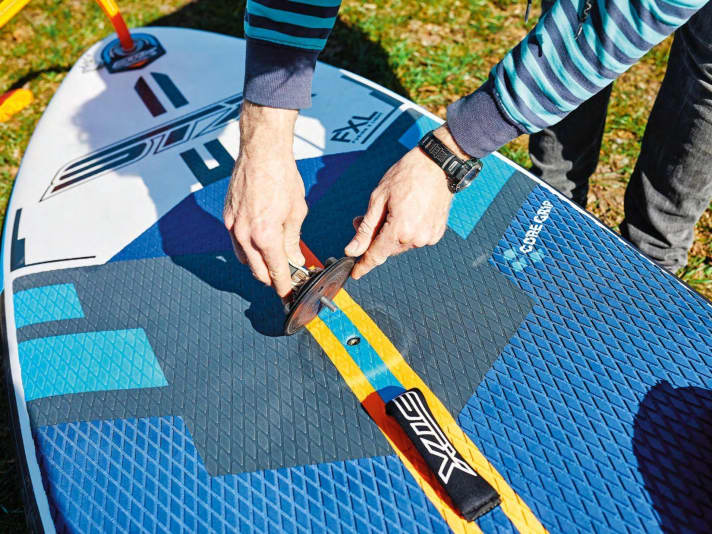
center fin:
Some providers market their board as a WindSUP even if it only has a mast foot mount. However, what distinguishes good from bad WindSUPs is the ability to mount one or more centre fins to prevent lateral drift. Full-fledged WindSUPs therefore have an additional fin box in the centre area or even a centreboard. Background: The round edges of inflatable boards, in particular, often have nothing to counteract lateral drift in light winds. Holding height and cruising are therefore difficult - especially if the boards are only motorised with small (children's) sails. When it comes to centre fins, the more surface area they have, the more effectively lateral drift is minimised.
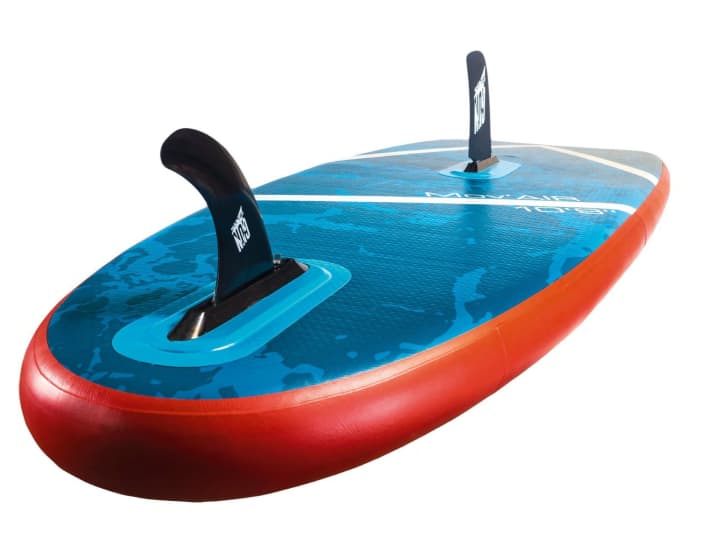
Upgrade with buckle:
The good news is that even a normal SUP can be converted into a WindSUP if it only has a threaded mast base mount but no centre fins. Several systems have proven themselves for this, such as the Add on Drift Stopperwhich is available from brands such as Fanatic or Duotone for just under 120 euros. Two fins are lashed to the board with a strap. On balance, the centre fins do not prevent lateral drift as effectively as a long daggerboard or a long centre fin. Nevertheless, they offer enough surface area to keep the board on course and at least significantly minimise lateral drift. Even tacking is possible with them, which is much more difficult without centre fin(s). The set works well between five and 15 knots of wind. In stronger winds, the fins slow you down noticeably - but most inflatable SUPs have long since reached their natural speed limit.
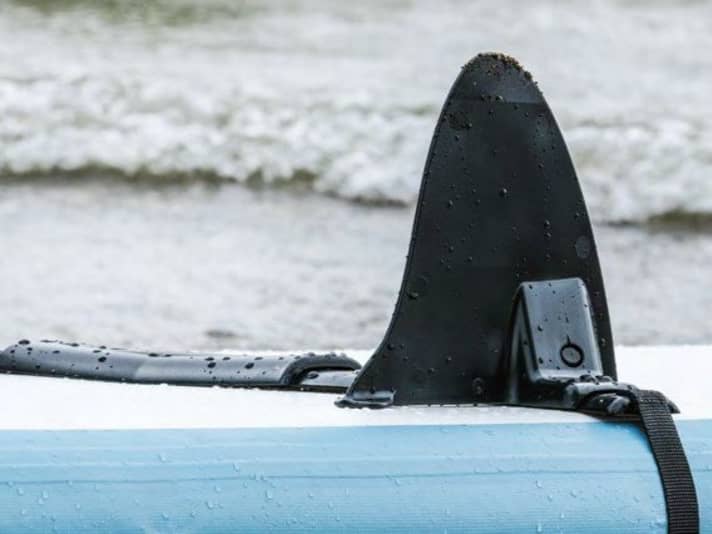
Similar to the Drift Stopper add-on, the Ezywing Fin Kit. It costs 129 euros and consists of an aluminium rail onto which two large plastic fins are attached. Assembly is simple and takes around two minutes; a simple tensioning strap system fixes the construction under the board. Tensioning is as simple as possible using a long Velcro strip on the deck. This has the advantage that no hard parts interfere with the deck and pose no risk of injury. The two side fins offer a lot of surface area and thus prevent lateral drift very effectively. Even in light winds, the height can be maintained well - regardless of whether you motorise your board with a wing or windsurf sail. Because the fins offer a lot of surface area with a shallow draft, the system can also be used on very shallow spots without any problems.
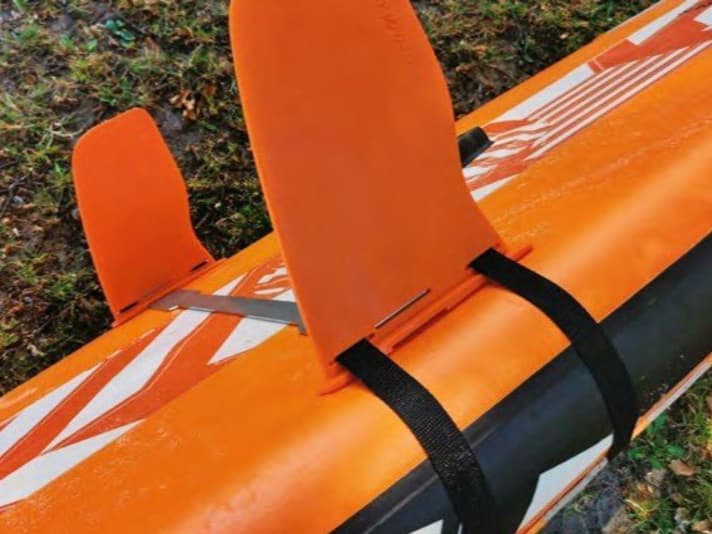
Another good tip is the FitOcean Wing-Fin System. Here too, a centre fin is tensioned under the board using two simple tensioning straps. The position can therefore be freely selected. Due to its generous length, the wing fins offer good protection against lateral drift. Another positive aspect: with a price of just 59 euros, the FitOcean system is comparatively inexpensive.

Manufacturer Slingshot offers the SUP Winder (119 euros) - a stick-on fin box into which a centre fin can then be mounted. Originally, the system was only developed for fixed SUPs, but Slingshot now also recommends the product for gluing onto inflatable SUPs. Ideally, you should stick the fin box on the centre line (mark it beforehand!) approximately halfway between the bow and tail. The fin has an immense amount of surface area, almost like a real daggerboard, which offers ideal conditions for tacking or windsurfing in light winds. The fin itself is removable, the box remains firmly glued to the board. Tip: When rolling up the board, do not fold it directly on the box!
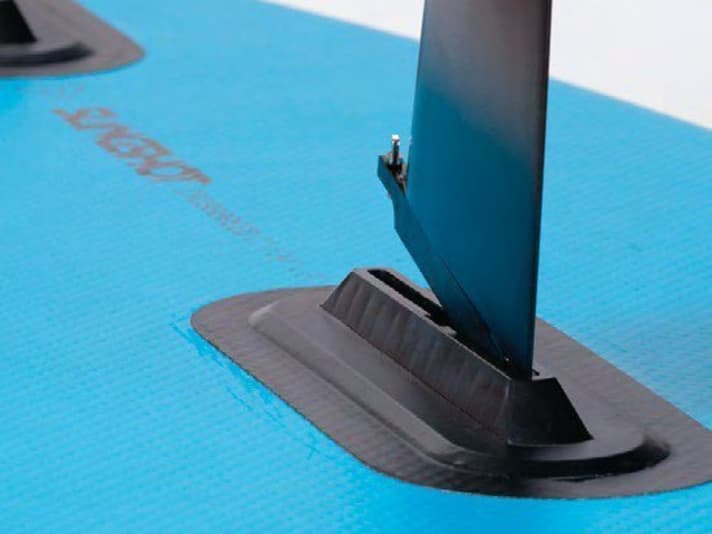
Sail or wing - which engine makes sense?
In addition to a windsurfing sail, wings are of course also possible as a drive for light winds. This makes sense for SUPs that do not have a mast foot mount. Without a centre fin, however, it is hardly possible with a wing. However, windsurf sails offer a big advantage over wings in light winds: the sail is firmly attached to the board, so you can have fun even in wind force one, as the sail is positioned on the board. Wings only provide enough lift to carry the weight of the sail when the wind force is just under three. When the wind drops, wing surfing feels about as relaxed as holding a drill up to the ceiling.

WindSUPs - hard or inflatable?
The most commonly sold SUPs are inflatable, and the advantages are immediately obvious: When packed, inflatables have the dimensions of a large rucksack, which de facto solves the storage and transport problem. Inflatables also have advantages in terms of weight - they are on average three to five kilos lighter than comparable hardboards. Another argument in favour of inflatables is the lower risk of injury compared to hardboards. Especially if children are also to use the board as a bathing and play island.
One downside is undoubtedly the tedious pumping work: even as a reasonably fit person, you have to pump for five to ten minutes, depending on the size of the board, until the warm-up programme is complete. The time required is about the same as if you were to attach a hardboard to the roof of your car for the journey to the spot.
In light winds, inflatable boards are almost as fast as hardboards.
Stephan Gölnitz, editor at surf and SUP magazine, can answer the question about paddling performance from his own test experience: "Hardboards make up for the weight disadvantage on the water thanks to their dimensional stability and better shape. The advantages of hardboards become greater the more performance-orientated the boards are shaped. However, with relatively short all-round boards with a length of ten feet, the advantages are small - and the board is only marginally faster than an inflatable board when paddling or light wind surfing. On long touring or even race boards between twelve (366 cm) and 14 feet (428 cm) in length, you slowly but steadily pull away with a hardboard - or require a little less effort," explains Stephan Gölnitz.
The differences are more pronounced in stronger winds: Inflatables have a natural speed limit here; more than a half-glide is rarely possible. This is primarily due to the fact that the round edges of inflatables get stuck as the speed increases. In addition, most WindSUPs are only equipped with unprofiled and soft plastic fins. This also explains why inflatable WindSUPs usually do not need foot straps.
From this point of view, hardboards have a clear advantage. Here, full fin boxes and fins are installed, allowing the shapes to glide at moderate speeds.
All-rounder or touring - the right WindSUP length
The dimensions of SUPs are usually given in the American measurements of feet and inches. One foot corresponds to 30.5 centimetres and one inch to 2.5 centimetres. A board with the specification 10'6'' would therefore be ten feet and six inches long, which corresponds to around 320 centimetres. Put simply, the most important models on the market can be divided into three categories: Short or children's boards, all-rounders and touring boards. We would like to briefly introduce you to the most important key data of the individual board classes as well as particularly windsurfing-suitable representatives below.
Children's and youth boards
For children to have fun windsurfing or wingsurfing on a SUP, the board should not be too long: Because with small sails or wings, the steering impulse is also weak - turning the board to tack or jibe becomes more and more difficult with increasing length. Boards with a length of less than ten feet are therefore ideal for children and teenagers; these can also be easily steered by small sails and wings with surfaces of less than three square metres. Common boards in this category are between 8'0 and 10'0 feet long. However, boards of this length are less suitable for pure stand-up paddling. For adults at least, they lack the straight-line stability that is desirable for longer tours - so you are primarily buying a windsurfing board rather than a SUP.
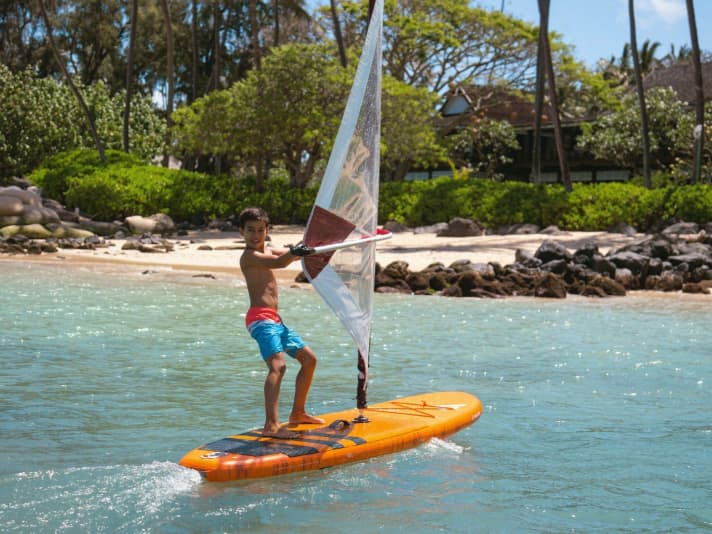
All-round boards
If you are still focussing on stand-up paddling, you should stick with a board of the appropriate length to achieve good directional stability. There are also numerous WindSUP models among inflatable all-round boards. These are usually between 10'0 and 11'0 long and offer a good combination of straight-line stability and manoeuvrability. In other words: Equipped with sails over 3.0 square metres, steering impulses are implemented quite well and the boards also run straight ahead at a decent basic speed. Such inflatables are almost as fast as hardboards at wind speeds of up to ten knots. However, even in stronger winds, it is not possible to glide more than halfway, as the wide bow usually pushes a lot of water in front of it.
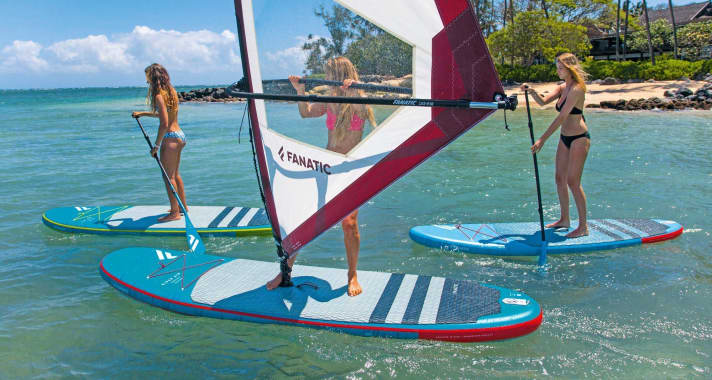
Touring boards
Length works! If you like paddling on extended tours, boards over the twelve-foot mark are ideal. Boards of this length are also well suited to windsurfing and wingsurfing, as they run wonderfully straight. When cruising upwind, they also have a clear advantage over shorter boards, as their long edges minimise lateral drift. The only drawback is that such long boards are not ideal for windsurfing for children and teenagers, as the steering impulse of small sails is barely sufficient to turn the boards properly. Inflatables are favoured by most end customers simply because of their pack size, but in light winds of up to ten knots, inflatables also keep up well at speed. However, if an experienced pilot is on deck and the wind is blowing at over ten knots, the fixed hardboards are noticeably faster. These can then also make sense as an introduction to planing surfing or trapeze surfing.
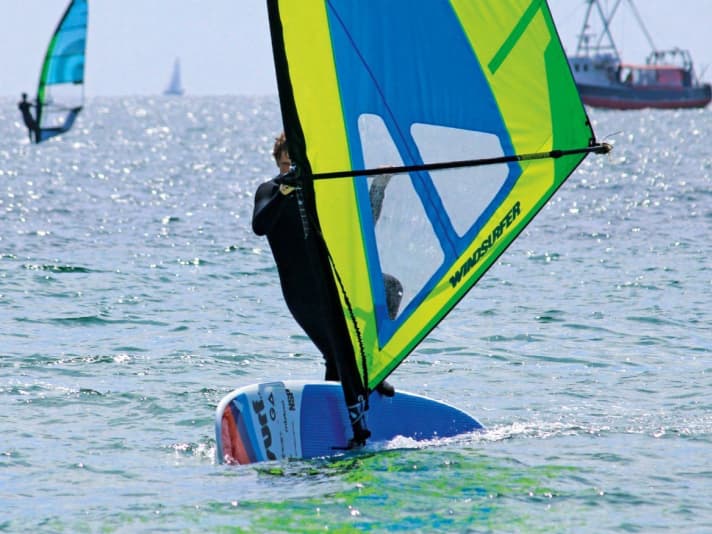
This article first appeared in surf 7/2023

